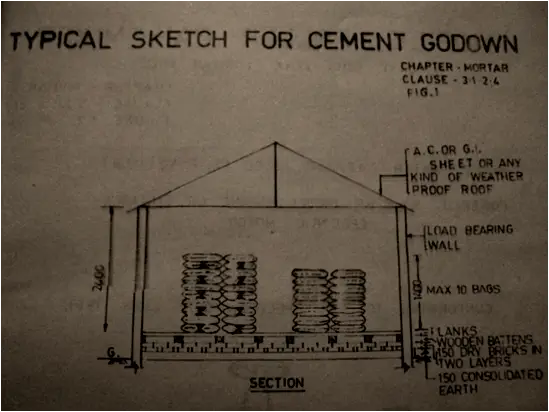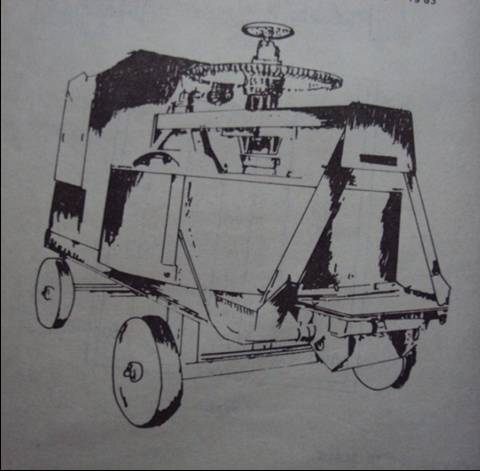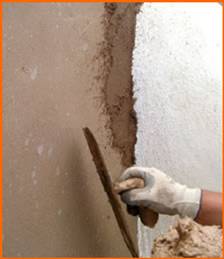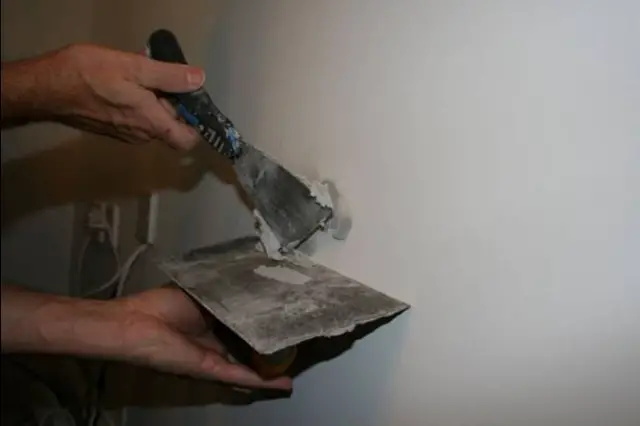- Water used for mixing and curing shall be clean and free from injurious quantities of alkalies, acids, oils, salts, sugar, organic materials, vegetable growth or other substances that may be deleterious to bricks, stones, concrete or steel.
- The PH value of water shall not be less than 6.
- Sea water shall not used for mixing and curing.
- Water used for curing shall not produce any objectionable stain or unsightly deposit on the surface.
- Water from the source shall be tested before the commencement of the work and thereafter once in every three months till the completion of the work.
![[filefield-description]](https://www.archinomy.com/wp-content/uploads/case-studies/2011/materials.jpg)
Cement:
One of the types of cement given below, as specified shall be used:
- 33grade OPC.
- 43 grade OPC
- 53 grade OPC
- Portland pozzolana cement
- Portland slag cement
- Masonry cement
- Rapid hardening portland cement
- Hydrophobic portlan cement
Different types of cement shall not be mixed together.
In case more than 1 type of cement is used in any work, a record shall be kept showing the location and type of cement used.
Fine Aggregate:
- It shall consist of natural sand, crushed stone sand or crushed gravel sand stone dust or marble dust, fly ash and surkhi.
- It shall be hard, durable, chemically inert, clean and free from adherent coatings, organic matter, etc.,and shall not contain any appreciable amount of clay balls, or pelletes and harmful impurities e.g. iron pyrites, alkalies, salts, coal , mica, shale or similar laminated materials
- The sum of the percentages of all deleterious materials shall not exceed 5%.
Silt Content:the maximum quantity of silt in sand shall not exceed 8%
- Type and grading of fine aggregate to be used shall be specified.
- Use of sea sand shall not be allowed unless otherwise specified.
Sand
Tests for silt content:
Sand shall not contain more than 8% of silt as determined by field test with measuring cylinder.
The method of determining silt content by field test-
- The sample of sand to be tested shall be placed without drying in a 200 ml measuring cylinder. The volume of the sample shall be such that it fills the cylinder upto 100 ml mark.
- Clean water shall be added upto 150 ml mark.
- Dissolve a little salt in water in the proportion 1teaspoon to half a litre , left for some time.
the last few sets being sidewise direction to level off the sand and the contents allowed to settle for 3 hours. - The height of the silt visible as settled layer above the sand shall be expressed as the percentage of the height of the sand below. The sand containing more than the above allowable percentage of the silt, shall be washed so as to bring the silt contents within allowable limits.
Stacking And Storage

|
|
Cement Mortat:
This shall be prepared by mixing cement and sand with/without the addition of pozzolana specified proportions.
Proportioning:
- cement bag weighing 50 kgs shall be taken as 0.035 cu m. other ingredients in specified proportions shall be measured using boxes of size 40 x 35 x 25 cms.
- Sand shall be measured on the basis of its dry volumes.
Mixing:
- the mixing of mortar shall be done in mechanical mixers operated manually or by power as decided by engineer in charge.
- In cases where mechanical mixers are not to be used, the contractor shall take permission of the engineer in charge in writing before the commencement of the work
Mechanical mixing:
-Cement and sand in the specified proportion shall be mixed dry thoroughly in a mixer.
-Water shall then be added gradually and wet mixing continued for at least 3 minutes
-Only the required quantity of water shall be added which will produce mortar of workable consistency
-only the quantity of mortar which can be used within 30 minutes of its mixing shall be prepared at a time.
-Mixer shall be cleaned with water each time before suspending the work.
Hand mixing:
-the measured quantity of sand shall be levelled on a clean masonry platform and cement bags emptied on the top.
-the cement and sand shall be thoroughly mixed dry by being turned over and over, backwards and forwards several times till the mixture is of uniform colour.
-the quantity of dry mix which can be used within 30 minutes shall then be mixed in a masonry trough with just sufficient quantity of water to bring the mortar to a stiff paste of necessary working consistency.
Precautions:
- Mortar shall be used as soon as possible after mixing and before it begins to set and in any case within half hour, after the water is added to the dry mixture.

Components Of Plaster
All plaster ideally comprises of 3 materials
- Binder: The substance, which basically holds together the layer or the coat
E.g. Lime (is the oldest used binder), Cement and Gypsum
- Aggregate: This comprises of the actual bulk of material in the layer or the coat
E.g. Various types of sand. The size of grains varies as per requirements and availability
- Water


Ceiling Plaster Wall Plaster
12mm Plaster
Preparation of Surface :
- The joints should be raked out properly.
- Dust and loose mortar shall be brushed out.
- Efflorescence, if any, shall be removed by brushing and
scrapping. - The surface shall then be washed and kept wet before
plastering is commenced. - Ceiling Plaster shall be completed before commencement of wall plaster.
- Plastering shall be started from the top and worked down towards the floor.
- All put-log holes shall be properly filled in advance of the plastering as the scaffolding is being taken down.
- To ensure even thickness and a true surface, plaster about 15cm X 15 cm shall be first applied, horizontally and vertically applied, at not more than 2 metres intervals over the entire surface to serve as gauges.
Thickness :
- The thickness of the plaster specified shall be measured exclusive of the thickness of key i.e. Grooves or open joints in brick work.
- The minimum thickness over any portion of the surface shall not be less than the specified thickness by 3 mm.
Curing:
- Curing shall be started 24 hours after finishing the plaster.
- The plaster shall be kept wet for a period of seven days.
- During this period, it shall be suitably protected from all damages as the contractor’s expenditure by such means as the Engineer-In-Charge may approve.
15 mm Lime Plaster
15mm lime plaster shall be done on the rough side of single or half brick wall. The average thickness of plaster shall not be less than 15mm and the minimum thickness of the plaster at any place shall not be less than 10mm.
18mm Plaster (Two Coats Work)
Application of plaster
The plaster shall be applied in two coats i.e.. 12 mm under coat and then 6mm finishing coat and shall have an average final thickness of not less than 18mm.
12 mm Under Coat: This shall be applied in the same manner as specified under 12mm lime plaster except that
- the finishing after the mortar has been brought to a level with the wooden straight edge, shall be done with a wooden float only
- during the process lime putty solution shall not be applied.
The surface shall be further roughened, by furrowing, about 2mm deep with a scratching tool diagonally, both ways to form a key for the finishing coat. The scratched lines shall not be more than 15cms apart. The surface shall be kept wet till the finishing coat is applied.
6mm Finishing Coat: The finishing coat shall be applied a day or two after the under coat has set. The latter shall not be allowed to dry out, before the finishing coat is laid on. The finishing coat shall be applied in a uniform thickness of slightly more than 6mm.The method of application shall be as described earlier except that the surface shall not be beaten with bamboo strips. The final thickness of the top coat shall be 6mm.
![[filefield-description]](https://www.archinomy.com/wp-content/uploads/case-studies/2011/calculation-of-quantity-of-mortar-and-materials.jpg)
Rates (included)

Measurement
Length and breadth shall be measured correct a cm, and its area shall be calculated in sqm.
- Thickness of plaster shall be exclusive of the key.
- Plastering on ceiling at height greater than 5m above the corresponding floor level Shall be so described and shall be measured separately .
- Flowing soffits shall be measured and paid for separately.
- Ribs and moulding on ceiling shall be measured as for cornices.
Rate
The rate shall include the cost of all labour and materials involved in all the operation.


Leave a Reply
You must be logged in to post a comment.